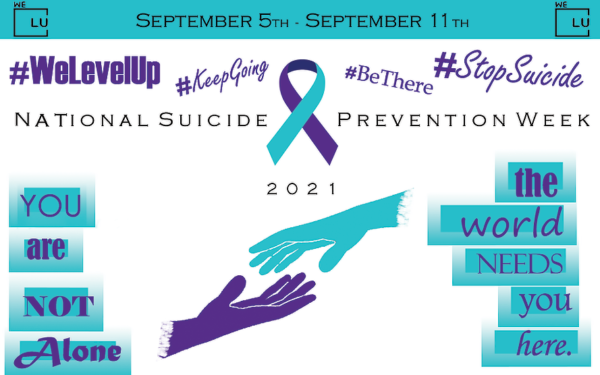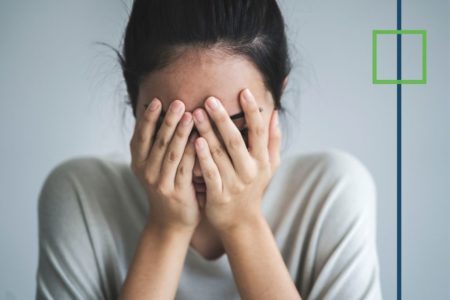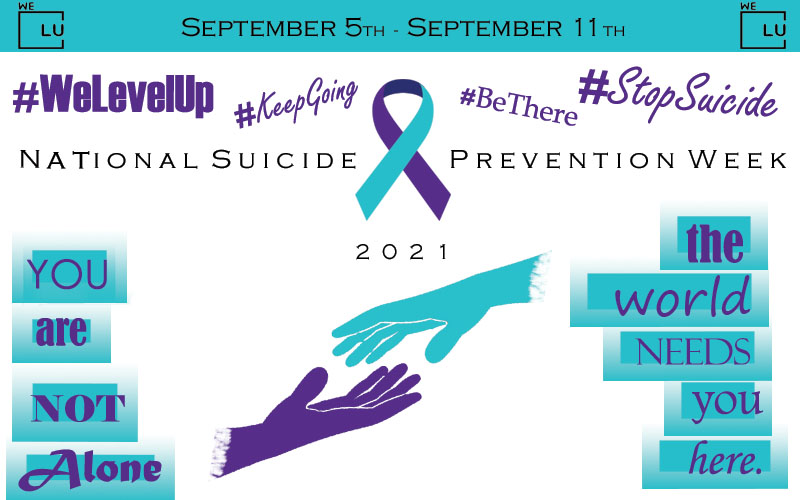National Suicide Prevention Week
National suicide prevention week is observed each September to raise awareness to reduce the stigma surrounding mental health. All too often, the stigma ends up stopping someone from asking for help.

“We all have mental health. It’s time we take the next step, ask more deeply about what someone is experiencing, and if we need it, find help together.
www.afsp.org
Together, we can help #StopSuicide.”
The Importance of Suicide Prevention
DC reported that starting in March 2020, the COVID-19 pandemic and response, which enforced physical distancing and stay-at-home orders, interrupted daily life in the United States. In June 2020, 25% of surveyed adults aged 18–24 reported experiencing suicidal ideation related to the pandemic in the past 30 days. Although some reports found increases in emergency department visits for suspected suicide attempts among adolescent females during 2020 and early 2021, this does not mean that suicide deaths have increased. [2]
Suicide is preventable, and everyone has a role in building healthy and safe communities that improve mental health. That is why we believe suicide prevention needs a comprehensive public health approach.

Suicide Attempts
Suicidal ideas or actions are indicators of extreme distress and a sign that help is required immediately. Talking about wanting to die by suicide is not a normal stress response. Given that, all conversation of suicide should be taken seriously and requires immediate attention.
Suicide is the act of taking one’s own life; an intentional, self-inflicted death to cease to physically exist. A Suicide Attempt is an act of carrying out a plan to die intentionally, but failing to do so. But living is not failing.
According to the U.S. National Institutes of Health [3], suicide does not discriminate. It can affect anyone, anywhere, at any time. But certain factors can increase the risk of suicide among certain populations, including the list below.
Factors That Can Increase The Risk Of Suicide
- History of attempts to commit suicide
- Depression and/or other mental health disorders
- Alcohol or drug use disorders
- History in the family of having a mental health disorder
- Family history of an alcohol or drug use disorder
- History of suicide in the family
- Family violence, including physical or sexual abuse
- Having lethal weapons at home, such as guns
- Being in or having recently gotten out of prison or jail
- Being exposed to others’ suicidal behavior, such as a family member, peer, or celebrity
- Medical illness, including chronic pain
- Stressful life events, such as a job loss, financial problems, loss of a loved one, a relationship breakup, etc.
- Being between the ages of 15 and 24 years or over age 60
National Suicide Prevention Week Reminds Us To Be Vigilant Regarding Suicidal Warning Signs
Some people may inform others about their suicidal thoughts. But others may try to conceal them, and this can make some of the signs more difficult to recognize. However, the following warning signs are the most common indicator of someone struggling with having suicidal thoughts.
- Talking about wanting to die or wanting to kill oneself
- Planning or looking for a way to kill oneself, such as searching online
- Buying a gun or stockpiling pills
- Feeling empty, hopeless, trapped, or like there’s no reason to live
- Being in unbearable pain
- Talking about being a burden to others
- Using more alcohol or drugs
- Acting anxious or agitated, behaving recklessly
- Sleeping too little or too much
- Withdrawing from family or friends or feeling isolated
- Showing rage or talking about seeking revenge
- Displaying extreme mood swings
- Saying goodbye to loved ones, putting affairs in order
Post-Covid Syndrome And Increased Suicide Risk During Pandemic
In the first few months of the viral pandemic, there were scattered media reports of individual instances of suicide ostensibly related to the effect of COVID-19.
A significant number of coronavirus disease SARS-CoV-2 (COVID-19) patients continue to have symptoms related to COVID-19 after the acute phase of illness. This post-COVID condition is sometimes called ‘post-COVID syndrome,’ ‘long COVID,’ or ‘post-acute COVID-19’. Persistent psychiatric symptoms among COVID-19 survivors such as depression, anxiety, post-traumatic symptoms, and cognitive impairment. COVID-19 related neurological symptoms including anemia, agnosia, dizziness, headache, and seizures may persist for a long time after the acute COVID-19 illness. Many COVID-19 survivors experience persistent physical symptoms such as cough, fatigue, dyspnea, and pain after recovering from their initial condition.
There is a high probability that psychiatric, neurological, and physical symptoms and inflammatory damage to the brain in individuals with post-COVID syndrome increase suicidal ideation and behavior in this patient population, according to Oxford University Press on behalf of the Association of Physicians. [4]
When the COVID-19 pandemic began, mental health advocates raised concerns about an increased risk of suicide that warranted attention; because of the already existing significant public health problem of suicide across Asia and the rest of the world.
During June 24–30, 2020, U.S. adults reported considerably elevated adverse mental health conditions associated with COVID-19. Younger adults, racial/ethnic minorities, essential workers, and unpaid adult caregivers reported having experienced disproportionately worse mental health outcomes, increased substance use, and elevated suicidal ideation. [5]
Suicide Prevention
Suicide touches all ages. It is the second leading cause of death for people ages 10-34, the fourth leading cause among people ages 34-54, and the fifth leading cause among people ages 45-54. [6]
People who attempt suicide often think it is the only way to stop their suffering. But, unfortunately, their feelings are honest and very difficult to deal with. Stigma, particularly surrounding mental disorders and suicide, means many people considering taking their own life or who have attempted suicide are not seeking help and are therefore not taking the help they need. Breaking down the wall of stigma is essential to conversation and understanding.

In addition, the prevention of suicide has not been sufficiently addressed due to a lack of awareness of suicide as a significant public health problem and the taboo in many societies to discuss it openly.
What You Can Do to Help
If someone you know is having suicidal thoughts or ideations, you should:
- Be straightforward. Talk openly and matter-of-factly concerning suicide.
- Ask if they are having thoughts of suicide. This will not drive the person to attempt suicide. You can ask:
- Are you thinking about ending your life?
- Do you have a plan for how and when you want to end your life?
- In the past couple or three months, have you taken any steps toward ending your life?
- Listen to their story without judgment and with genuine empathy. Allow expression of feelings. Show interest, be supportive, and let them know you care.
- If you are not sure what to do, contact a counselor to guide you.
- Call 911 if they are in critical danger and you are unable to intervene. A person is in immediate danger if they plan to attempt suicide, have access to a lethal method, and want to attempt suicide soon.
How To Cope When A Loved One Dies By Suicide
Suicide and suicide attempts affect the health and well-being of our friends, loved ones, co-workers, and the community. When somebody dies by suicide, their surviving family and friends may encounter shock, anger, guilt, symptoms of depression or anxiety, and may even share suicidal ideations themselves.
According to American Psychological Association [7], these are the advice for mourning adults and dealing with a death by suicide.
- Accept Your Emotions: You might suppose to feel grief and despair, and these feelings are normal and can vary during the healing process.
- Be Patient with yourself: Don’t worry about what you “should” feel or do because there’s no standard timeline for grieving
- Practice Self-Care: Do your best to get sufficient sleep and eat regular, healthy meals. Taking Care of your physical self can lift your mood and give you the strength to cope.
- Lean On Existing Support Systems: Accept help from those who care about you
- Talk To Someone: There is often a stigma around suicide, and many loss survivors suffer in silence. Opening up about your feelings can help.
- Join Support Groups: Support groups can help you process your emotions alongside others experiencing related feelings.
Above all, it could be best if you can talk to a professional. Psychologists and other mental health professionals can help you formulate and manage your feelings and find healthy coping mechanisms.
Behavorial Health Secondary Addiction Disorders Facts
Inpatient medical detox and residential primary addiction treatment may be available at our affiliated facility at Level Up Treatment Center West Palm Beach. For some primary behavioral health treatment clients, medical detox may be required first. If you have a co-occurring severe substance abuse diagnosis, please contact us prior to beginning inpatient mental health therapy. Treatment services may vary. Please call us to learn which treatment options are most suited for your individual needs.
Substance use, misuse, and dependency are notable contributors to the risk level for overdose deaths and suicide. In addition, suicidal behavior is a significant problem for people with co-occurring disorders seeking addiction treatment.
Several predisposing risk factors, such as marital and interpersonal relationship separation, occupational and financial stressors, recent heavy substance use and intoxication; as well as a history of previous suicide attempts and sexual abuse, combine in an additive manner with personality traits and mental illnesses to intensify risk for suicidal behavior in addiction patients.

Major depression, bipolar disorder, borderline personality disorder, and post-traumatic stress disorder (PTSD) are significantly correlated with suicidal behavior in people with addictive disorders. [8]
According to the Centers for Disease Control and Prevention (CDC), women are more prone to attempt suicide than men, but men are more likely to die by suicide than women. This may be because men are more apt to attempt suicide using very lethal means, such as a firearm or suffocation (e.g., hanging). And then, women are more likely to attempt suicide by poisoning, including overdosing on prescribed drugs or unprescribed prescription and illicit drugs. [9]
Given that, treatments such as medication-assisted treatment (MAT) for opioid use disorders and cognitive behavioral therapy (CBT) for suicidality are effective, and access to these need to be increased.
Active And Passive Suicidal Ideation
Most people control their suicidal ideation and do not attempt suicide, even when reporting suicidal ideations. In addition, the Psychiatric Association Practice Guidelines for Psychiatric Evaluation of Adults point out that suicidal ideation is a symptom of another primary psychiatric diagnosis and suggests that 90% of people who end their lives by suicide meet the diagnostic criteria for one or more psychiatric diagnoses. [10]
On the other hand, the CDC’s mortality records for 2017 report over 50% of deaths by suicide were by people with no known psychiatric illness. There is also an “active” suicidal ideation that indicates experiencing current, specific suicidal thoughts. And then, “passive” suicidal ideation refers to a general wish to die but when there is no plan of inflicting fatal self-harm to kill oneself.
Older adults are more apt to show their passive suicidal ideation and less likely to express active suicidal thoughts or seek mental health care than younger groups. Unfortunately, the majority die on their initial attempt.
Data show that 10% of people who ended their lives by suicide visited an emergency department within two months of inflicting fatal self-harm. That is why people who have psychiatric histories, substance use disorders, or depression were most likely to be assessed for suicidal ideation.

If you discern warning signs of suicide—particularly a change in behavior or new, concerning behavior—get help as soon as possible.
Family and friends are usually the first to notice the warning signs of suicide, and they can take the first step toward helping a loved one find mental health treatment.
If someone says that they are going to kill themselves, do not leave them alone. Do not guarantee that you will keep their suicidal thoughts a secret—inform a trusted friend, family member, or other trusted adult.
If you have suicidal ideations, tell your health care provider. Your health care provider will listen to your concerns and help you figure out the next steps and refer you to treatment.
As we observe the annual national suicide prevention week, we have this hope that the message of ending the stigma will echo even after these 7 days.
About We Level Up FL Mental Health Center
We Level Up FL is a primary mental health treatment center that applies evidence-based modalities and holistic programs to improve client recovery outcomes. Combining co-occurring secondary behavioral health elements of SUD treatment, including supervised medical recovery coupled with intensive behavioral rehab.
Offering cutting-edge advanced therapies, We Level Up FL is an accredited pending co-occurring dual diagnosis primary mental health care provider. Fully integrating co-occurring conditions into our programs. Most importantly, our top-notch doctors, therapists, and counselors leverage the power of science to help clients succeed in rehab recovery.
We provide best-in-class treatment in multiple locations, with amenities and activities designed to reinforce recovery success metrics. In addition, each client receives lifetime alumni support post inpatient treatment along with family resources to help maintain recovery momentum, even once they depart our treatment facilities.
Above all, our vision is to help create legions of self-empowered individuals who are entirely in control of their lives and destinies, enabling them to get what they desire from this life, experiencing it to their fullest, most liberating potential. Through these hosts of self-empowered and self-aware individuals, we will see families that communicate with more love, trust, and caring for one another, businesses that thrive in ways never before thought possible, and friendships that reach new heights.

Who Is Ryan Zofay?
In 2019 he founded the Level Up Development Series. Level Up is a unique development program that provides attendees with the tools and knowledge to eliminate limiting thoughts from their lives and to reach their full potential. As Ryan Zofay explains in his February 2020 Sober Nation podcast interview, he invests in the people who he hires because with a strong team, together, they can make a difference.
Ryan Zofay is most passionate about sharing his practical lessons that change lives. As a successful entrepreneur and motivational speaker, he teaches development strategies that improve performance, connection, and overall mindset.
Using the teachings of his successes and tribulations, Ryan has a unique ability to facilitate significant change for individuals and organizations. In addition, Ryan’s passion and enthusiasm readily spill over to his listeners.
Moreover, his life accounts, incredible comeback journies, along with the wisdom he developed, help formulate instructions on how to realize your goals. Visit the Ryan Zofay Events page for further more details.
If you consider primary behavioral health with or without co-occurring secondary addiction treatment for you or someone you love, We Level Up FL may help. Please contact us today for a confidential consultation with a member of our intake team. Get more information regarding National Suicide Prevention Week.
Sources:
[1] One in 100 deaths is by suicide – World Health Organization
[2] Emergency Department Visits for Suspected Suicide Attempts Among Persons Aged 12–25 Years Before and During the COVID-19 Pandemic — United States, January 2019–May 2021 – Centers for Disease Control and Prevention
[3] Suicide – U.S. National Library of Medicine / National Institutes of Health
[4] Mental Health, Substance Use, and Suicidal Ideation During the COVID-19 Pandemic — June 24–30, 2020 – Centers for Disease Control and Prevention
[5] Post-COVID syndrome and suicide risk – National Library of Medicine
[6] Suicide Prevention – Centers for Disease Control and Prevention
[7] Coping after suicide loss – American Psychological Association
[8] Addiction and suicide: A review – National Center for Biotechnology Information
[9] Frequently Asked Questions About Suicide – National Institute of Mental Health
[10] Suicidal Ideation – National Center for Biotechnology Information